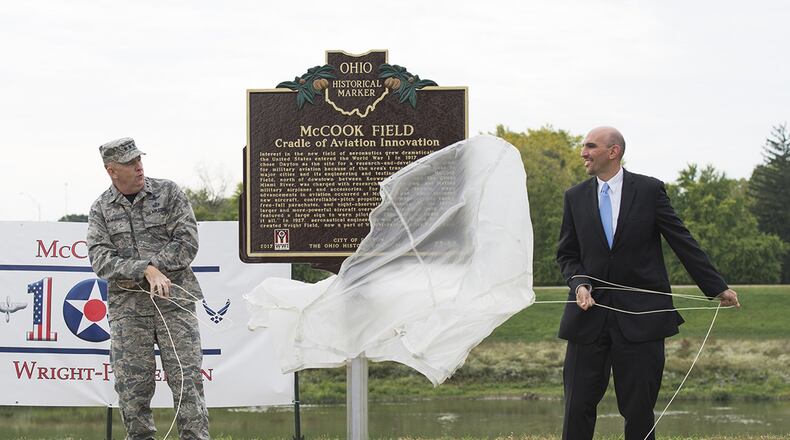“It is fitting for us to start our ceremony with a parachute jump,” Moore said. “Nearly a century ago, the first freefall manual bailout parachute was developed and tested here at McCook Field. The parachute was the first practical means of escaping from a disabled aircraft in flight and soon became standard equipment for early military aviators.”
Col. Bradley McDonald, commander of the 88th Air Base Wing and installation commander at Wright-Patterson Air Force Base, commented on the achievements of today’s 27,000-plus civilian, officer and enlisted Airmen and their families from the base.
“The difference that we’re making today for the nation could not happen without the great support that we continue to have, and all of that started 100 years ago here at McCook Field. We continue to break barriers today and a lot of that is because of the work that’s being done at Wright-Patterson Air Force Base,” McDonald said.
In the summer of 1917, efforts by the Dayton community led to the selection of the site for a temporary experimental station that would eventually become McCook Field. There were many significant developments in aviation and aeronautics made here which established the location’s reputation as the ‘Cradle of Aviation.’ From materials, fuels and lubricants, to high-altitude flight, aerial photography, propulsion, navigation, armaments, lighter than air flight and aerodynamics, the tradition continues at today’s Air Force Research Laboratory.
Maj. Gen. William Cooley, commander of the Air Force Research Laboratory, highlighted a few innovations developed at McCook Field in the early years, including synchronization of machine guns and propeller blades and materials science and research.
“Think of this field through the generations,” said Lt. Gen. Robert McMurry, commander, Air Force Life Cycle Management Center. “Generation to generation, it took on a new life. In every generation it did something that the previous generation thought was impossible. Just a year or so before the Wright brothers flew, there were people in the press saying vehemently, ‘It will never happen.’
“Within about a decade, we had taken what the Wright brothers did in meticulous development of controlled flight and brought it to genuine applications. During World War II, we built thousands and thousands of aircraft, based on the research that was done here. From the B-17 and the B-24, to the P-38, P-40, P-51, just amazing numbers of aircraft and pilots to fly them,” said McMurry.
He spoke of other advancements, built on generational knowledge learned since the McCook Field success stories, including precision attack capability, the integration of GPS and space capabilities, and pilot-vehicle integration.
“All of that came because of the work done here at Wright-Patterson, based on its history and lineage at McCook Field. None of that would have been possible were it not for the professional and strong relationships that developed between this field, this Air Force base, the workers here and the community that surrounds it,” McMurry said.
About the Author
